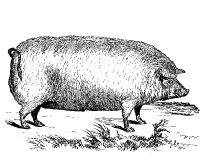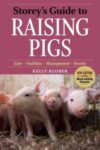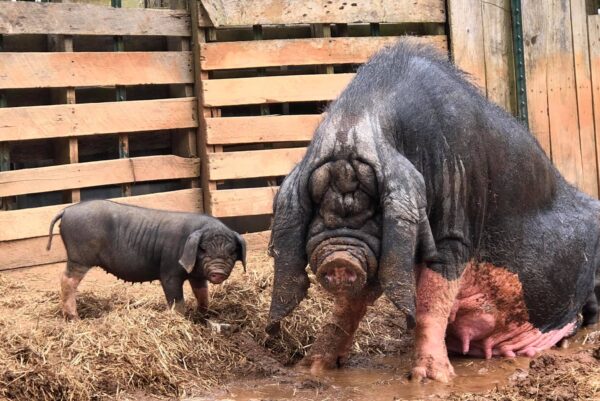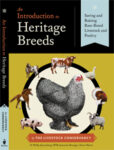
Breed Facts
Status:
Threatened
Use:
Meat, Lard/Back Fat
Adult Weight:
Male – 275-375 lbs.
Female – 300-400 lbs.
Temperament:
Docile
Experience Level:
Beginner
Notes:
May be used for Charcuterie, Roasts, Sausage/Ground, Ham
MEISHAN
The Chinese have been selectively breeding domestic swine for over 5,000 years. The Meishan is one of the oldest, if not the oldest, domesticated pig breed in the world. It is part of the Taihu group of Chinese pigs that also includes Fengjing, Jiaxing, Erhualian, and Hengjing strains from different districts of China. The Meishan is named after the lake in China’s Jiangsu province.
Taihu pigs are prized in China and Japan for their succulent marbled meat and superior lard and fat quality. The Meishan is considered a medium-sized lard-carcass hog. There were originally three sub-types known as the “small,” “middle,” and “large.” Of the three types, only the small and middle remain today. The two types are managed as separate breeds on conservation farms in China. In the US, only the middle type exists. Meishans were bred for hyper-productivity and prolificacy, and to thrive in smaller areas and on rougher diets than other pig breeds. In conjunction with these traits, Meishans have been bred to be extremely quiet, docile, and sedentary, making them easier to manage than larger or more active breeds.
Meishans were first imported into the US in 1989 after ten years of negotiations with China. They were brought in as part of a joint study between the USDA, Iowa State, and the University of Illinois. Only 99 Meishans were imported and were equally divided – both by sex and genetic profile – among the three participating research facilities. This marked the third, final, and largest exportation of Meishans allowed by China in modern times. Other exportations were significantly smaller and those went to France and England.
Under the agreement between the USDA and China, Meishans were restricted to use in research facilities or zoos until the prolificacy experiments were concluded. Iowa State dispersed its herd between 2008-2010. The USDA and the University of Illinois dispersed their herds entirely in 2016. None of the original research facilities currently maintain Meishan herds. It’s important to point out that the three research herds spent over 20 years in total genetic isolation from one another, and none were interbred until pigs were placed in private hands beginning in 2016, so there are truly three genetically distinct bloodlines of Meishans in the US.
The American Meishan Breeders Association (AMBA) was established and originally incorporated in Tennessee in October of 2016. The AMBA holds the herd book and manages registration services, recognizing foundation pure stock by using a documented chain of custody back to one of the three research herds. It also allows for grade “pure on appearance” females only. Percentages of bloodlines are tracked, and COI is available on animals with at least a three-generation pedigree. The AMBA uses a breed description and tracks litter sizes as a performance criterion.
Meishans were imported specifically to be studied for their hyper-productivity. By their third farrowing, Meishan pig litter size is typically 14-16 piglets and occasionally 20 or more. A sow in the USDA research herd once farrowed 28. In addition to their large litters, they also enter puberty at approximately 90 days, significantly faster than most domestic hog breeds. Sows typically have 16-18 teats, and sometimes over 20, allowing them to easily raise large litters of piglets. They are excellent mothers and, in study herds, had higher weaning-to-farrowing ratios than conventional breeds. Meishan piglets are born with more highly developed digestive systems than conventional swine. This is believed to make the piglets more resistant to piglet digestive diseases allowing for earlier weaning.
Meishan pigs are a sedentary breed and sleep much of the day. They often have to be awakened when it is feeding time! They are a quiet breed except when they are in heat. Unlike most pig breeds, Meishans thrive on a diet higher in fiber and roughage; they are a true grazing hog and can thrive on pasture. They are also thought to have a lower environmental impact on pastures compared to other heritage and commercial swine breeds. They can be easily kept confined as they do not test fences, and they can also get along well with other types of livestock. Their lard (banyou) is of high quality and said to be finer and of lighter taste than the lard of commercial hogs. Meishan pork a delicacy in East Asia and is to pork what Kobe Beef is to beef.
The population level of this ancient breed of pig is low, and the breed is in need of dedicated stewards.
Did you know:
The Livestock Conservancy is America’s leading organization working to save over 190 heritage breeds from extinction. We rely on the support of our members, grants, and donations from the public to raise the $1 million needed each year to maintain our conservation work with rare breeds of farm animals. Click here to learn how you can help.
You may be interested in…

Storey’s Guide to Raising Pigs
– Kelly Klober
$19.95
An Introduction to Heritage Breeds
– D. Phillip Sponenberg, Jeannette Beranger. Alison Martin
$19.95


